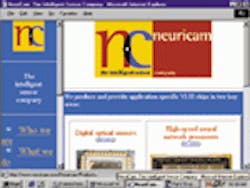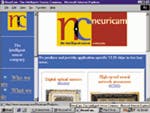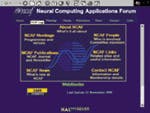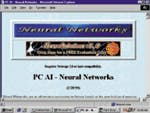Wilson's Websites
Based on the human nervous system, neural networks are composed of a number of interconnected processing elements or neurons. Using learning by example to resolve problems, neural networks can be configured for such tasks as pattern recognition by adjusting the synaptic connections between the neurons. This month we look at some of the currently available hardware and software being used to develop machine-vision and image-processing systems, as well as some typical applications.
High-speed neural nets
www.neuricam.com/
NeuriCam (Trento, Italy) builds VLSI neural processors and intelligent optical sensors. On the company's Web site, there are complete descriptions of the two types of products and future developments that include a new class of sensor chip, one capable of neural processing directly on chip. Here, too, you'll find downloadable data sheets, application notes, technical papers, and a primer on neural networks.
Neural briefs
www.emsl.pnl.gov:2080/proj/neuron/neural/briefs.html
Pacific Northwest National Laboratory (Richland, WA) is a national laboratory operated by Battelle Memorial Institute for the US Department of Energy. On its Web page, the laboratory has provided a list of neural-network technology briefs that can be downloaded. Subjects include artificial neural networks as information analysis tools, medical uses of neural networks, and computer-assisted medical-diagnosis applications.
Building a brain
www.genobyte.com/
With the aim of building an artificial brain by 2001 with a billion artificial neurons, the CAM (Cellular Automata Machine) is a research tool conceived by Hugo de Garis at the evolutionary systems department of ATR HIP (Kyoto, Japan). Currently, the system is being implemented by Genobyte (Boulder, CO), on whose Web site you'll find a description of an artificial brain with 32,000 neural network modules (each with 1152 neurons) based around FPGA hardware. To test the device, the CAM will first be used to control the behavior of a kitten robot called Robokoneko (Japanese for robot child cat).
Applications forum
www.ncaf.co.uk/
Based in Egham, Surrey, England, the Neural Computing Applications Forum is an independent, nonprofit organization that offers those interested in neural computing a newsletter, an international journal, and a series of meetings thoughout the year. On this site there are links to software providers and consultants, universities working on neural-network projects, and related conferences.
Neural reference
www.primenet.com/~terry/New_Home_Page/ai_info/neural_nets.html
For a quick comprehensive reference to hardware, software, related papers, and conferences, check out this Web site developed by Knowledge Technology (e-mail: [email protected]). As well as listing much of the neural-network information available on the Internet, the site includes book references, a glossary of terms, and links to hardware and software vendors including BioComp (Redmond, WA), Mikuni Berkeley R&D (Northridge, CA), NeuralWare (Pittsburgh, PA), and The Math Works (Natick, MA).
Hunting images
attrasoft.com/
Attrasoft (Savannah, GA) offers two software packages on its Web site. Capable of simulating Hopfield and Boltzmann neural networks, the PolyNet 4.0 and PolyNet for Windows 95/98 are described along with the company's ImageHunt, an Internet image search engine that can run either locally or on the Internet. In addition, there are many examples of face and satellite retrieval images.



